- Home
- Publications et statistiques
- Publications
- Economics: where are the women?
Post n°51. In 2017, several studies revived the debate in the United States on the place of female economists in the profession and on the barriers to progress that had to be lifted. In most countries, women are poorly represented in all fields of economics (19% on average worldwide) and the situation is stagnating over time. However, significant differences exist between countries. In France, for example, women are a little more present, particularly among assistant professors.
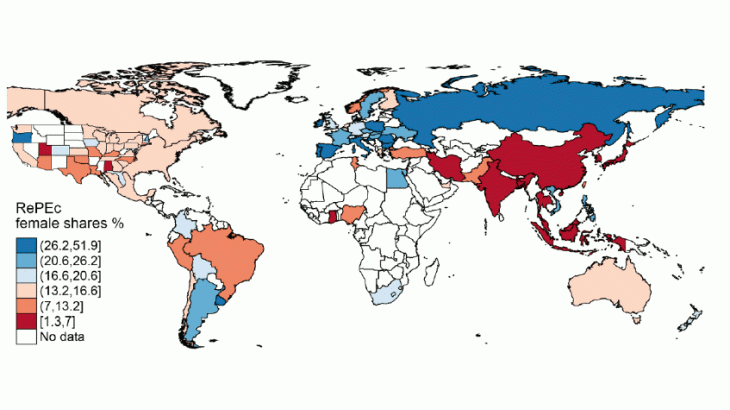
Source: Female representation in Economics, RePEc, January 2018.
In the summer of 2017, a study by Alice Wu caused an outcry in the profession by revealing the sexist comments posted on the American anonymous online forum, Economic Job Market Rumors. The study was widely reported in the New York Times, prompting the American Economics Association (AEA) to draft a code of professional conduct. Other studies, including a recent article by Amanda Bayer and Cecilia Rouse, show that the under-representation of women in the profession has a negative impact on research quality (by reducing the diversity of opinion) and teaching (by discouraging female students from studying economics).
What proportion of economists are women, worldwide?
The majority of studies on the (under-)representation of women in economics draws on US data. For the purpose of this article, we use the RePEc (Research Papers in Economics) database, which includes more than 52,000 authors of economic research papers from all around the world. RePEc provides new insights by facilitating international, specialisation‑based comparisons over time. According to RePEc (see Map 1), female representation in European countries exceeds the world average of 19%, particularly in Latin countries (30% in Italy, 27% in Spain and 26% in France) and Eastern Europe (in Romania in particular, where 52% of economists are women). Women are largely under-represented in Anglo-Saxon countries, with only 16% in the United States and 18% in the United Kingdom (pink in Chart 1). The picture in Latin America varies, while the proportion of female economists in Asia is extremely low, at 6% in Japan, China and India.
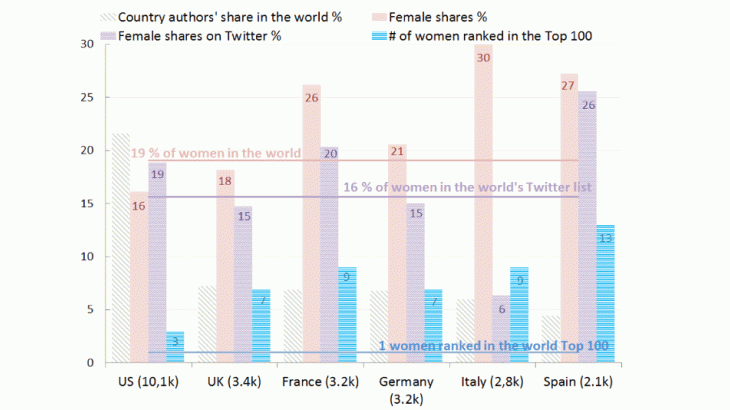
Sources: Female representation in Economics, academic rankings by country and for the world (as of January 2018), and RePEc-Twitter lists.
Of the approximately 1,200 RePEc Economists active on Twitter, only 16% are women (purple in Chart 1). In the Top 25% of Economists by Twitter Followers, the proportion of women falls to less than 13% and only eight women are ranked among the 100 most-followed economists. Furthermore, the audience of the female economists in this Top 25% does not reach 7% (excluding Paul Krugman, and his 4 million followers), suggesting that there is a shortfall not only in supply, but also in demand for women's views. This under-representation is even more striking in the RePEc rankings for the number and impact of publications, in which there is only one woman among the 100 top ranked economists in the world (blue in Chart 1). France fares better than the United States and the United Kingdom but lags behind Spain, particularly in terms of the number of women ranked in the top 100 economists by country (9 compared with 13 in Spain).
The proportion of female economists can even fall to 9%-12% in the fields in which women are least represented (finance, time series and sports economics) while rising to 32%-37% in fields in which they are most present (demography, Eastern economies and tourism) – a breakdown is available here. Anusha Chari and Paul Goldsmith-Pinkham also show that women are particularly under-represented in finance, macroeconomics and international economics. In terms of evolution over time, Chart 2 shows that female representation in economics by cohort of PhD graduates (based on RePEc data) has stagnated over the past 20 years at around 17%-18%. In the United States, the proportion has even declined: according to Justin Wolfers, only 35% of economics undergraduate students are women, compared with a little over 40% in the second half of the 1990s.
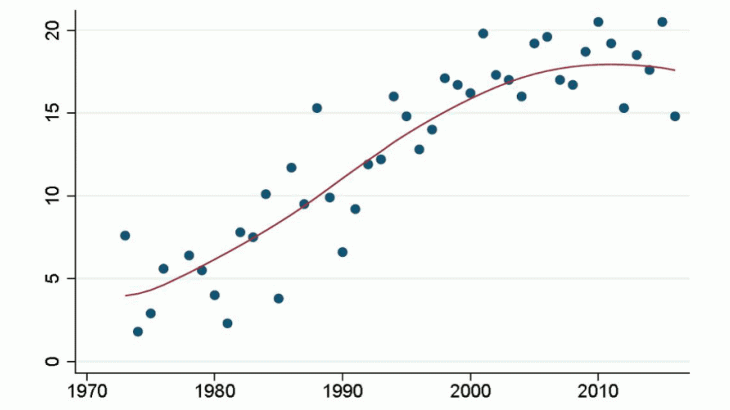
Source: Female representation in Economics, RePEc, January 2018.
What about France?
According to data for 2016-17 from the French Ministry of Higher Education, Research and Innovation, women are better represented among students in France, with 43% and 51% of first-year undergraduates and Masters students, respectively, but 38% of economics PhD students. This proportion has remained relatively stable since 2010-11, despite a slight decline in women studying economics at PhD level (down from 41% in 2010).
While only 29% of assistant professors and 14% of full professors in economics in the United States are women, the situation is better in France, where, in 2016, women accounted for 43% of assistant professors and 24% of full professors (Chart 3, left-hand graph). As the right-hand graph in Chart 3 illustrates, the proportion of men and women in the youngest cohort (less than 36 years old) is almost equal. It remains to be seen whether these young female assistant professors will become full professors in the same proportions as their male colleagues. As for researchers with CNRS (Centre national de la recherche scientifique), Clément Bosquet, Pierre-Philippe Combes and Cecilia García-Peñalosa also highlight significant promotion gaps between women working as “research fellows” and as “research directors”.
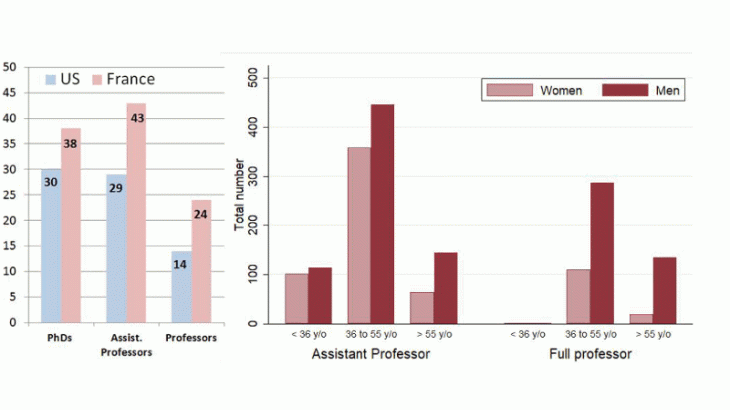
Sources: Open data Enseignement Supérieur et Innovation for France and Justin Wolfers for the United States.
Lastly, in terms of female representation, economics sits rather close to the average compared with other academic disciplines in France (see Chart 4). Generally speaking, the disciplines with the highest proportion of female assistant and full professors are also those – logically – in which the majority of Masters students are women. To give an example from another field in social sciences, in 2016, 56% of assistant professors and 36% of full professors in sociology were women, compared with 65% and 59% of Masters and PhD students, respectively. In the United States, the relative situation of women appears less favourable and less dynamic in economics than in other disciplines. According to a study based on National Science Foundation data, this has led to dissatisfaction being far greater among women than among men in the economics profession, while smaller differences in satisfaction between men and women were observed in other scientific fields such as mathematics, computer science or physics.
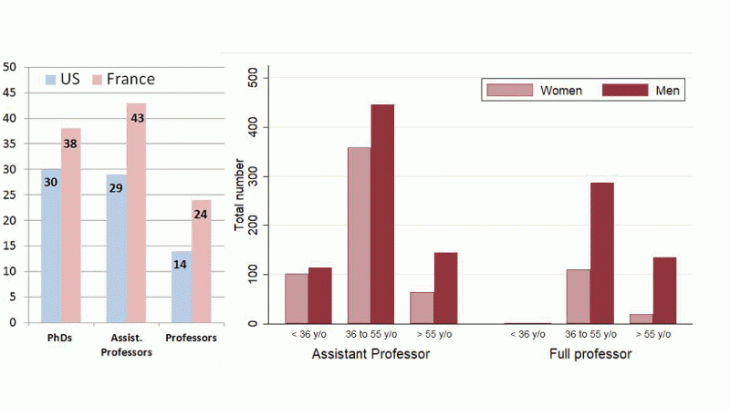
Source: Open data Enseignement Supérieur et Innovation.
Updated on the 25th of July 2024